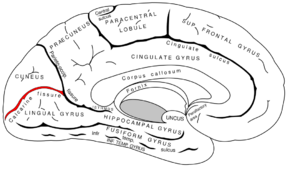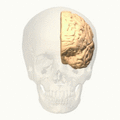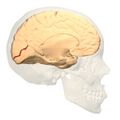Biology:Calcarine sulcus
| Calcarine sulcus | |
|---|---|
 Medial surface of left cerebral hemisphere. ("Cricoid fissure" visible at left.) | |
 Coronal section through posterior cornua of lateral ventricle. (Label for "Calcarine fissure" visible at bottom. | |
| Details | |
| Part of | Occipital lobe |
| Artery | calcarine branch of medial occipital artery |
| Identifiers | |
| Latin | sulcus calcarinus, fissura calcarina |
| Anatomical terms of neuroanatomy | |
The calcarine sulcus (or calcarine fissure) is an anatomical landmark located at the caudal end of the medial surface of the brain of humans and other primates. Its name comes from the Latin "calcar" meaning "spur". It is very deep, and known as a complete sulcus.
Structure
The calcarine sulcus begins near the occipital pole in two converging rami.[1] It runs forward to a point a little below the splenium of the corpus callosum. Here, it is joined at an acute angle by the medial part of the parieto-occipital sulcus.[1] The anterior part of this sulcus gives rise to the prominence of the calcar avis in the posterior cornu of the lateral ventricle. The cuneus is above the calcarine sulcus, while the lingual gyrus is below it.[2][3]
Development
In humans, the calcarine sulcus usually becomes visible between 20 weeks and 28 weeks of gestation.[4]
Function
The calcarine sulcus is associated with the visual cortex.[5] It is where the primary visual cortex (V1) is concentrated.[2][6] The central visual field is located in the posterior portion of the calcarine sulcus, and the peripheral visual field is located in the anterior portion.
History
The name of the calcarine sulcus comes from the Latin "calcar" meaning "spur".[7]
Additional images
-
Position of the calcarine sulcus (shown in red).
-
Calcarine fissure (shown in red).
-
Calcarine sulcus highlighted in Brodmann Area 17, Lateral and Medial views.
-
Medial surface of cerebral cortex - gyri
References
- ↑ 1.0 1.1 Johns, Paul (2014). "3 - Functional neuroanatomy" (in en). Clinical Neuroscience. Churchill Livingstone. pp. 27–47. doi:10.1016/B978-0-443-10321-6.00003-5. ISBN 978-0-443-10321-6. https://www.sciencedirect.com/science/article/pii/B9780443103216000035.
- ↑ 2.0 2.1 Swenson, R. S.; Gulledge, A. T. (2016). "12 - The Cerebral Cortex" (in en). Conn's Translational Neuroscience. Academic Press. pp. 263–288. doi:10.1016/B978-0-12-802381-5.00021-X. ISBN 978-0-12-802381-5. https://www.sciencedirect.com/science/article/pii/B978012802381500021X.
- ↑ Wen, Hung Tzu; Rhoton, Albert L.; Mussi, Antonio C. M. (2017). "2 - Surgical Anatomy of the Brain" (in en). Youmans and Winn Neurological Surgery (7th ed.). Elsevier. pp. 49–75. ISBN 9780323341493.
- ↑ "Embryology and Anatomy of the Brain" (in en). Diagnostic Imaging: Obstetrics - Diagnostic Imaging (3rd ed.). Elsevier. 2016. pp. 68–83. doi:10.1016/B978-0-323-39256-3.50023-6. ISBN 978-0-323-39256-3. https://www.sciencedirect.com/science/article/pii/B9780323392563500236.
- ↑ Osborne, Benjamin J.; Liu, Grant T.; Newman, Nancy J. (2007). "8 - Cranial Nerve II and Afferent Visual Pathways" (in en). Textbook of Clinical Neurology (3rd ed.). Saunders. pp. 113–132. doi:10.1016/B978-141603618-0.10008-6. ISBN 978-1-4160-3618-0. https://www.sciencedirect.com/science/article/pii/B9781416036180100086.
- ↑ Cechetto, David F.; Topolovec, Jane C. (2002). "Cerebral Cortex" (in en). Reference Module in Neuroscience and Biobehavioral Psychology - Encyclopedia of the Human Brain. Academic Press. pp. 663–679. doi:10.1016/B0-12-227210-2/00087-X. ISBN 978-0-12-227210-3. https://www.sciencedirect.com/science/article/pii/B012227210200087X.
- ↑ "Anatomy Glossary". http://www.anatomy.usyd.edu.au/glossary/glossary.cgi?page=c.
External links
- "Anatomy diagram: 13048.000-3". Roche Lexicon - illustrated navigator. Elsevier. http://www.tk.de/rochelexikon/pics/s13048.000-3.html.
- https://web.archive.org/web/20090310124713/http://www2.umdnj.edu/~neuro/studyaid/Practical2000/Q31.htm
- Atlas image: eye_38 at the University of Michigan Health System - "The Visual Pathway from Below"
- NIF Search - Calcarine Fissure via the Neuroscience Information Framework
 |





